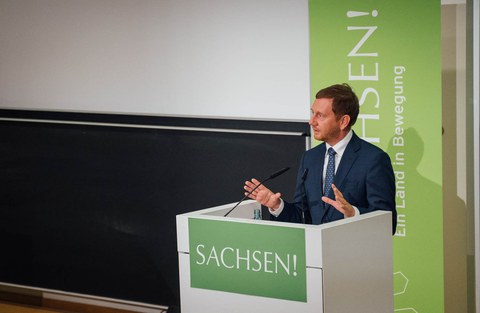Sep 09, 2020
20 years biotechnology initiative in Saxony

Saxony's Prime Minister Michael Kretschmer opening the Life Sciences Forum at the CRTD of the TU Dresden looking back on 20 years of Saxony's biotechnology initiative
15,500 employees, an annual turnover of almost two billion euros, numerous companies and research institutes located mainly in Dresden and Leipzig, international courses of study and two clusters of excellence. The results of Saxony's biotechnology offensive launched in 2000 are impressive. Equipped with 200 million euros, the Free State of Saxony launched the life science locations Dresden and Leipzig. This is how the Biotechnology Center of the TU Dresden (BIOTEC) came into being, which has its home in the BioInnovation Center Dresden. With its originally six professorships and junior research groups it became the nucleus of biotechnological research at the TU Dresden.
The aim of the BIOTEC was to combine state-of-the-art research approaches in molecular and cell biology with the traditionally strong engineering sciences in Dresden. Interdisciplinary research in order to make the latest life science findings quickly applicable became the mission of the BIOTEC, which since then has focused on the research areas of molecular cell and developmental biology, physical biology and bioinformatics.
BIOTEC, which was opened in 2001 as a central scientific institution at the TU Dresden, has developed over the past 20 years into today's Campus Johannstadt with the Center for Regenerative Therapies Dresden (CRTD), founded in 2006, the Center for Molecular Bioengineering (B CUBE), founded in 2008, and the Center for Molecular and Cellular Bioengineering (CMCB), created in 2016 as the umbrella organization for all three institutes.
Today, the biotech cluster met at the Life Sciences Forum Saxony at the CRTD of the TU Dresden to look back on 20 years of Saxony's biotechnology offensive and discuss the health technologies of the future together with Saxony's Prime Minister Michael Kretschmer. "With its three specific international master's programs, the TU Dresden is attracting attention worldwide. Teaching is in English, seven out of ten of our CMCB Master students join TU Dresden from abroad. Many of them enrich our almost 50 biotechnological research groups after their graduation or become important network partners at other institutes or in industry. Thanks to its strong international networking and distinctive interdisciplinary research, the TU Dresden is able to attract additional top researchers, acquire extensive third-party funding and further stimulate the growth of the Saxon biotech cluster," explains Rector Prof. Ursula M. Staudinger.
Overall, the institutes of the Johannstadt Campus have had a lasting impact on the research profile line "Health Sciences, Biomedicine and Bioengineering" of the TU Dresden and, with their two clusters of excellence CRTD (funded from 2006 to 2019) and currently Physics of Life (PoL), have made a decisive contribution to the success of the university in the federal and state Excellence Initiative since 2012.
"With their research, the scientists of the CMCB make a significant contribution to the excellent and globally recognized development of the life sciences at the TU Dresden. Together with the non-university scientific institutions, the institutes form a strong and internationally competitive center for bioengineering with a broad scientific background ranging from molecular and cell biology, medicine, physics, chemistry, materials science to bioinformatics," says Staudinger.
"Over the past 20 years, we have been able to build a world-class technology platform and keep it at the cutting edge of science. As CMCB we operate ten modern facilities, which are also intensively used by our research partners", explains Prof. Stefan Diez, Managing Director of the CMCB and research group leader at B CUBE.
Application-oriented research is a top priority at the Johannstadt Campus: The base researchers work closely with scientists from the University Hospital and the Medical Faculty, but also with many non-university institutions that have settled in Dresden in recent years. These include the Max Planck Institute of molecular Cell Biology and Genetics, the Max Planck Institute of Physics of Complex Systems, the Center for Systems Biology Dresden, the German Center for Neurodegenerative Diseases, the German Center for Diabetes Research, the Max Bergmann Center for Biomaterials Dresden, the National Center for Radiation Research in Oncology (OnkoRay) and various spin-off companies.
Overview facts and figures:
- 2001: Foundation of the Biotechnology Center of the TU Dresden (BIOTEC)
- 2006: Foundation of DFG Research Center and Cluster of Excellence for Regenerative Therapies Dresden (CRTD)
- 2008: Foundation of B CUBE - Center for Molecular Bioengineering as Center for Innovation Competence (ZIK) by the initiative "Unternehmen Region" of the Federal Ministry of Education and Research
- 2016: Foundation of the Center for Molecular and Cellular Bioengineering (CMCB) as an umbrella organization of the three institutes BIOTEC, CRTD and B CUBE with three international Master's programs and a common technology platform, such as the Dresden-concept Genome Center or the Biopolis Dresden Imaging Platform
- 2018: Foundation of the DFG Cluster of Excellence Physics of Life (POL)
- Establishment of three international Master's programs (teaching entirely in English, proportion of international students around 70 percent:
- 2002: Molecular Bioengineering
- 2007: NanoBiophyscis
- 2010: Regenerative Biology and Medicine
- 2020: 29 TUD professorships at the CMCB and PoL (some still in appointment), in addition 20 independent junior research groups
- CMCB: about 500 employees, about 35 percent come from outside Germany from 30 different nations, everyday language English
